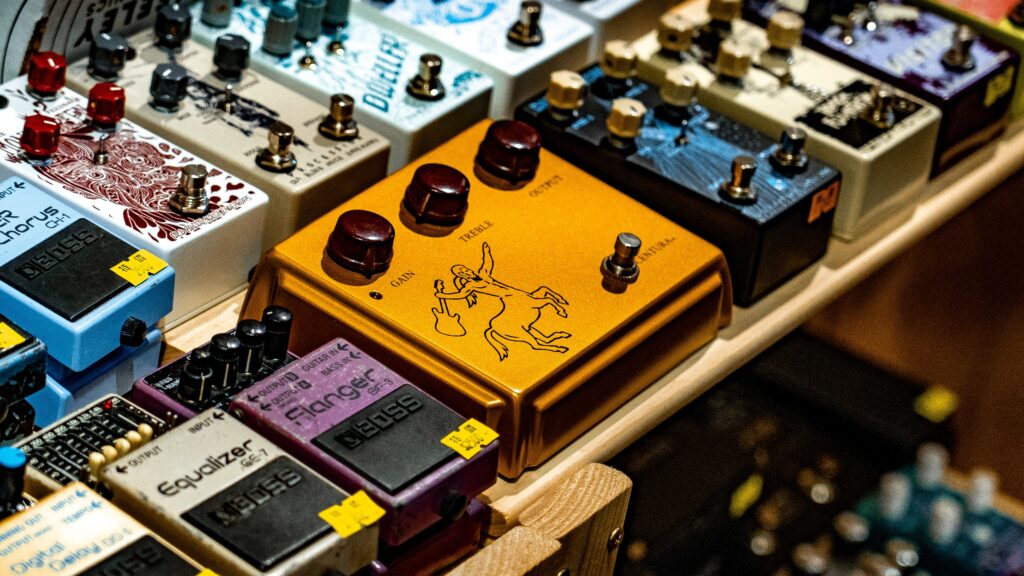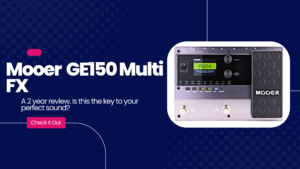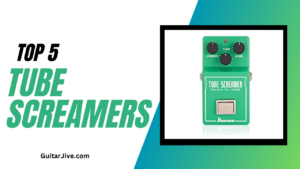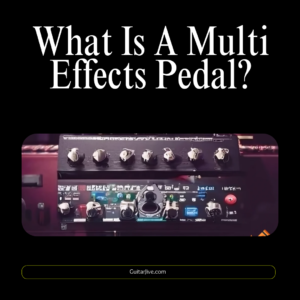As a beginner guitarist, the importance of utilizing guitar pedals cannot be overstated. These compact devices can enhance your playing by adding various effects to your sound, allowing you to experiment with different tones and styles. Whether you’re aiming for a gritty distortion or a dreamy reverb, the right guitar pedals can make all the difference in your musical journey.

“This page contains Affiliate Links. This means if you make a purchase through this site, I may earn a small commission at no extra cost to you.”
What are guitar pedals?
Guitar pedals, also known as stompboxes, are electronic devices that alter the sound produced by an electric guitar. They are typically housed in a small enclosure that can be easily activated or deactivated by stepping on the pedal. Each pedal is dedicated to a specific effect, such as distortion, delay, reverb, wah-wah, or chorus. By connecting these pedals in a sequence, you can create a unique chain of effects that shapes your guitar tone.
Different types of guitar pedals
There is a wide array of guitar pedals available, each catering to a specific effect category. Distortion and overdrive pedals add grit and crunch to your sound, while delay and reverb pedals create spacious and ambient effects. Wah-wah and envelope filter pedals allow you to manipulate the frequency range of your guitar, adding a dynamic touch to your playing. Tuner and compressor pedals help you fine-tune your sound and provide control over dynamics. Modulation pedals, such as chorus, phaser, and flanger, add depth and texture to your tone. Lastly, volume and expression pedals enable you to adjust volume levels and manipulate certain parameters on other pedals.
How guitar pedals affect the guitar tone
Guitar pedals play a crucial role in shaping the tone of your instrument. They can transform a bland sound into something captivating and unique. Distortion pedals, for example, add crunch and saturation to your signal, resulting in a heavier and more aggressive tone. On the other hand, delay and reverb pedals create a sense of space and depth, allowing your guitar to resonate in a larger environment. By understanding how each pedal affects your tone, you can select the ones that best complement your musical style and preferences.
Best Effects Pedals for Beginners
Pedal Pedal Name Ibanez Tube Screamer TS808 Boss DS-1 Distortion TC Electronic Polytune MXR Dyna Comp TC Electronic The Prophet Delay Electro Harmonix Holy Grail MXR M234 Analog Chorus MXR Phase 95 Boss BF-3 Flanger Click Here








Overdrive and Distortion Pedals
Recommended overdrive pedal
- Overdrive pedals provide a smooth and natural distortion effect by emulating the breakup of a tube amplifier.
- They maintain the dynamics and nuances of your playing, allowing for a more expressive performance.
- Ibanez Tube Screamer: Known for its iconic mid-boost and smooth overdrive tones.
Recommended distortion pedal
- Distortion pedals offer a more aggressive and intense tonal character compared to overdrive pedals.
- They are essential for genres like hard rock, heavy metal, and punk, providing the necessary bite and sustain.
- Boss DS-1 Distortion: A versatile distortion pedal that suits various playing styles


Tuner and Compressor Pedals
Recommended tuner pedal for beginners
- Tuner pedals provide accurate and quick tuning, helping beginners develop a good ear for pitch.
- They eliminate the need for separate tuners and are essential for gigging musicians.
- TC Electronic Polytune: A popular tuner pedal that is known for its fast, polyphonic tuning capabilities.
Recommended compressor pedal
- Compressor pedals even out the dynamic range of your playing, adding sustain and enhancing the overall tone.
- They are particularly useful for beginners to help improve technique and control.
- MXR Dyna Comp: A classic compressor pedal that enhances sustain and dynamics.


Delay and Reverb Pedals
Recommended delay pedal
- Delay pedals create echoes that repeat after a certain delay time, adding depth and complexity to your sound.
- TC Electronic The Prophet Delay: Offers digital delay types, intuitive controls and true bypass.
Recommended reverb pedal for beginners
- Reverb pedals simulate acoustic reflections in different spaces, providing a sense of ambiance and richness.
- Electro-Harmonix Holy Grail Reverb: Provides lush and vintage-inspired reverb sound.


Volume and Expression Pedals
Recommended volume pedal
- Volume pedals allow you to control the volume of your guitar with a foot pedal, providing smooth and gradual changes.
- Dunlop VP5 Volume Pedal: A compact and affordable volume pedal with a durable construction.
Recommended expression pedal for beginners
- Expression pedals let you control specific parameters on other effects pedals, such as modulation speed or delay feedback.
- Moog EP-3 Expression Pedal: Offers precise control and compatibility with a wide range of effects.


Modulation Pedals (Chorus, Phaser, Flanger)
Explanation of modulation effects
- Chorus pedals create a shimmering and spacious effect by emulating multiple guitar sounds playing together.
- Phaser pedals produce a swirling and sweeping sound by shifting the phase of the guitar signal.
- Flanger pedals offer a distinct whooshing effect, similar to a jet flying by, for a more detailed explanation see What Is Flanger?
Recommended modulation pedals for beginners
- MXR M234 Analog Chorus: Known for its lush and warm chorus tones.
- MXR Phase 95: A compact phaser pedal used by many guitarists.
- Electro-Harmonix Electric Mistress Flanger: Provides rich and swirling flanger effects.


Factors to Consider Before Buying Guitar Pedals
Budget considerations
Before diving into the world of guitar pedals, it’s important to establish a budget. While there are pedals available to fit any budget, it’s vital to strike a balance between quality and affordability. Remember that as a beginner, you might not require high-end or expensive pedals. Set a realistic budget and focus on acquiring pedals that provide the essential effects you need to enhance your playing.
Pedals for specific music genres
Different music genres often require different effects to achieve the desired sound. If you have a specific genre in mind, it’s worth considering pedals that are commonly used within that genre. For example, if you’re into heavy metal, a distortion pedal with high gain capabilities would be essential. Explore the effects commonly used in the music you enjoy and select pedals accordingly.
Durability and build quality
Guitar pedals experience a fair amount of stomping and abuse, so investing in pedals with sturdy construction is wise. Opt for pedals made from quality materials that can withstand the rigors of live performances and rigorous practice sessions. Many manufacturers offer compact and durable pedal enclosures that are both lightweight and roadworthy, ensuring that they will stand the test of time.
How To Set Up And USe Guitar PEdals

Basic pedalboard setup
To set up your pedalboard, start with an empty surface or a dedicated pedalboard. Arrange the pedals in a logical order, considering the signal flow. A typical signal chain starts with the tuner pedal, followed by compression, overdrive/distortion, modulation, delay/reverb, and ends with the volume pedal. Use patch cables to connect the pedals, keeping the signal path clean and minimizing any unwanted noise. Bear in mind there is no right or wrong way, so experiment with different pedal orders to find the arrangement that suits your style. See Pedalboard Signal Chain
Tips for connecting and arranging pedals
- Use shielded cables to minimize unwanted noise and interference.
- Take advantage of velcro or pedalboard tape to secure the pedals in place and prevent them from sliding during performances.
- Consider using a power supply instead of batteries for a reliable and consistent power source.
- Experiment with different pedal combinations and settings to discover unique and inspiring sounds.
Summary
Learning how to utilize guitar pedals and discover your perfect tone is a journey, just like learning to play the guitar. Your pedal collection will evolve in tandem with your playing and preferences. Trial and error is part of the learning process, so get out there, grab a tube screamer, and have some fun!
If you ever have questions about gear. Drop a comment below and we’ll help you out.
You May Also Like:
Make Music Magic with Top Effects Pedals for Beginners
As a beginner guitarist, the importance of utilizing guitar pedals...
Read MoreMooer GE150 Multi FX ultimate 2-Year In-Depth Review.
Is the Mooer GE150 Multi FX the key to your...
Read MoreTop 5 Tube Screamer Pedals. You Need To Try One!
A tube screamer is one of the most important pedals...
Read MoreWhat Is a Multi-Effects Pedal? you need to try one!
Introduction Are you looking to get the most out of...
Read More


